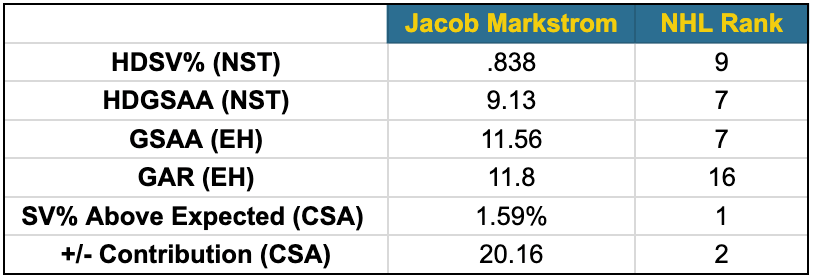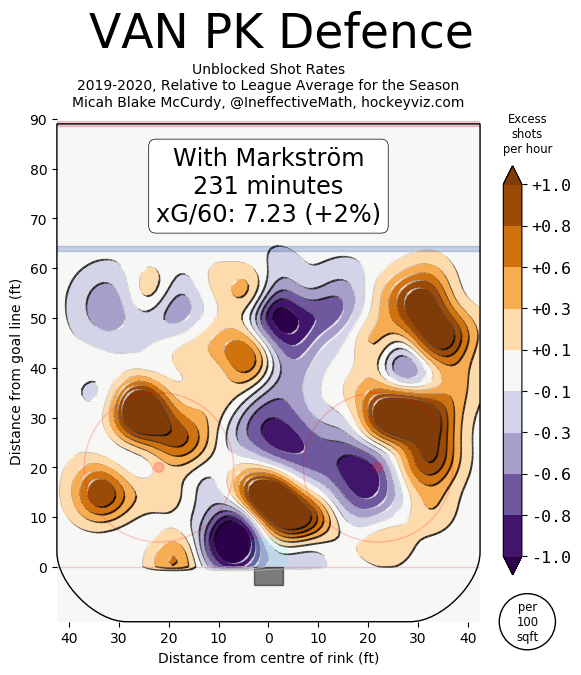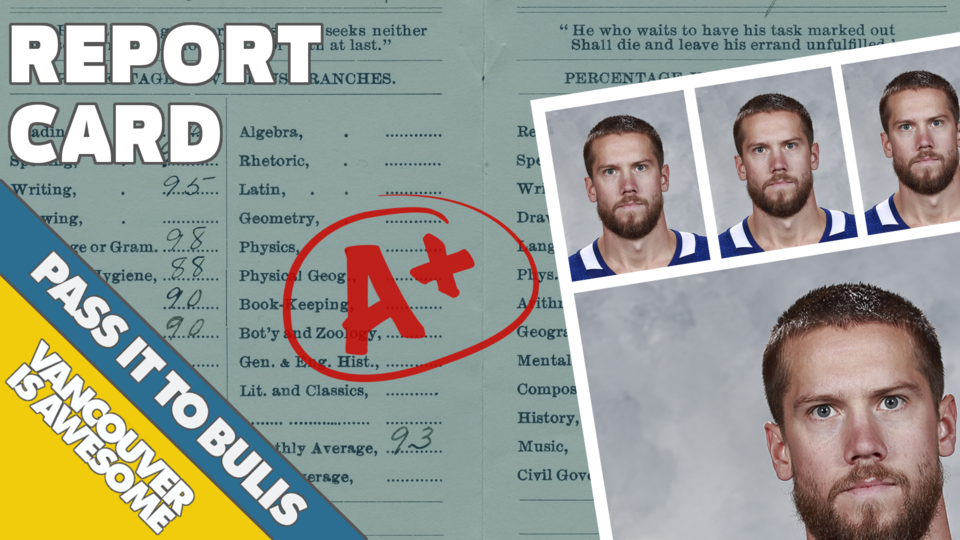Without Jacob Markstrom, the Canucks wouldn’t have made the playoffs this past season. Now the Canucks need to figure out if they need him to make the playoffs next season too.
Markstrom will be an unrestricted free agent on October 9th when free agency opens unless the Canucks can get a deal done with the goaltender in the next week.
On a surface level, the decision to re-sign Markstrom should be dead simple. He won the Cyclone Taylor Trophy as the Canucks’ most valuable player as voted by the fans and finished fourth in Vezina voting for the league’s best goaltender. When you’ve got a goaltender that good, there’s an argument for simply opening up your wallet and letting him take what he wants.
It’s not that simple. With the flat cap and some bad contracts on the books, the Canucks don’t have a lot of room to maneuver, especially since they also want to re-sign Tyler Toffoli and Chris Tanev. The Seattle Kraken expansion draft is less than a year away, which complicates matters, as a no-movement clause in Markstrom’s contract would force the Canucks to protect him and expose Thatcher Demko. Other teams around the NHL are able to pay more for Markstrom than the Canucks can afford, something of which his agent is well aware.
And then there’s the nagging thought that, at 30 years old, Markstrom might not be able to maintain his high level of play much longer. Work done on ageing curves for goaltenders by Hockey Graphs shows that, on average, a goaltender’s decline becomes most noticeable after the age of 30.
Perhaps Markstrom can be one of the goaltenders at the upper end of the bell curve and defy time, but the effects of age can’t be easily dismissed.
All of those elements have to be factored into Markstrom’s contract negotiation, which is probably why a contract hasn’t been worked out yet. There’s still a week to go, however, which is plenty of time for a deal to get done. Before that happens, let’s take a look back at Markstrom’s 2019-20 season in his Report Card.
Math (Boxcar Numbers): A-
Markstrom’s boxcar numbers were solid this season, but maybe not as good as you might expect. His .918 save percentage was well above the league average of .910, but nowhere near the top goaltenders in the league. Among goaltenders with at least 20 starts, Markstrom ranked 14th in save percentage and 27th in goals against average.
In terms of workload, Markstrom started 43 of the Canucks’ 69 games, 11th in the NHL. He won 23 of those starts, also 11th in the NHL.
To be fair, Markstrom did face a high volume of shots against: only Robin Lehner, who split his season between the Chicago Blackhawks and Vegas Golden Knights, faced more shots per game than Markstrom.
In the playoffs, among the 19 goaltenders that played at least five games, Markstrom’s .919 save percentage was 11th and his 2.85 goals against average was 15th. Those numbers are good, but not great, and were blown up by two games against the Vegas Golden Knights where he gave up five goals.
If we’re just going by the boxcar numbers, Markstrom was above average this season, but came just short of the top tier of goaltenders. A grade of A- seems fair here.
Science (Fancy Stats): A+
Here’s where things get interesting for Markstrom. Anyone watching Canucks games knows that Markstrom faced both a high volume of shots and also a high number of dangerous scoring chances. He bailed out his teammates on a regular basis.
It can be difficult to capture that in numbers, however, to compare how difficult the shots Markstrom faced were to those faced by other goaltenders. Public data from the NHL is useful for this purpose, but still limited: each unblocked shot has a shooter, a location, and a shot type, but that’s it.
There are all sorts of interesting things you can do with that data. Analysts have used it to model how likely a shot is to result in a goal, but it’s also missing a lot of crucial information when we’re looking at goaltenders. Was the shot screened? Was there a pass prior to the shot? Did the pass significantly change the location and angle of the shot? Was it a one-timer?
Proprietary data from Clear Sight Analytics (CSA) aims to solve this by manually tracking shot sequences, including elements like passes, screens, and broken plays. From this, they model the probability that each scoring chance will result in a goal.
There are some issues with depending on CSA’s work. It’s a black box in that its data and model are not available to the public, so haven’t been scrutinized and tested by others to see if the results are meaningful and repeatable. Also, because their data isn’t available to the public, we can’t see where every goaltender ranks: they only publish the very best and the very worst.
Fortunately for our purposes, Markstrom ranks among the very best.
Here are numbers from Natural Stat Trick (NST), Evolving Hockey (EH), and CSA.
 Jacob Markstrom's 2019-20 fancy stats
Jacob Markstrom's 2019-20 fancy statsMarkstrom’s save percentage on high-danger scoring chances was .838 in all situations, good for 9th in the NHL according to NST. He saved 9.13 goals above an average goaltender on high-danger chances, ranked 7th.
His overall Goals Saved Above Average for the season was 11.56, also 7th, and his Goals Above Replacement was 11.8, ranked 16th.
From these analytics, Markstrom looks slightly better than his boxcar statistics, bumping him up into the top-10 in the NHL. According to CSA, he should be a lot higher than that.
“On clear-sighted shots, ones where he’s set up in his stance and he’s got clear vision of the shot, he’s the best goalie in the league,” said Steve Valiquette, former NHL goaltender and CEO of CSA, back in March. “If I was doing the Vezina Trophy voting, I would have him at the top of my list.”
“He’s stolen 8 games for the Vancouver Canucks this year,” he added. “Flat-out stolen 8 games and that’s the most of any goalie in the NHL. He’s conservatively, by my measure, given the Canucks 15 additional points in the standings.”
Based on the quality of shots he faced, Markstrom’s save percentage on the shots they tracked should have been .891. Instead, his save percentage was .907, a difference of 1.59% (.016). That’s a massive swing and better than any other goaltender in the NHL this season.
By the reckoning of CSA, the number of goals Markstrom saved the Canucks wasn’t 11.56 like GSAA would suggest, but 20.16. That’s second behind only Connor Hellebuyck, who played 15 more games than Markstrom.
According to CSA, Markstrom wasn’t just good this season, he was the best goaltender in the entire NHL. Troy Stecher said it best: “It’s absolutely mindboggling to me that [Markstrom] wasn’t a Vezina candidate.”
Despite the black box nature of CSA’s numbers, I’m going to put my trust in them and give Markstrom an A+ in Science.
Social Studies (Leadership and Intangibles): A+
While Markstrom has an occasionally cold relationship with the media, he is extremely well-liked by his teammates. He is a driven, passionate teammate that “works his bag off,” as the players are fond of saying. In many ways, he sets the tone for the team with his work ethic and, even without a letter on his chest, he’s a leader in the room.
All season, Markstrom was quick to give credit to his teammates for wins and take responsibility for losses. That sent a message to his fellow Canucks all season long that he had their backs.
Beyond that, he has a surprisingly great sense of humour that doesn’t always come out with the media. One time it did come out with the media, I ended up as the butt of one of his jokes.
I was the first reporter into the room after a practice and when I looked back, there were no other reporters behind me, so it was just me in a room full of Canucks. I joked, "Looked like it's just me today."
Markstrom looked at me and deadpanned, "The room's still closed, we're having a players-only meeting."
I paused. Took a step back and looked around the room. "Oh, uh...sorry, they said the room was open..." and that's when the entire room busted up laughing. "He got you so good!" said one Canuck. I had to laugh as the rest of the reporters came in, with no clue why the whole room was laughing.
It was a great, hilarious moment.
Markstrom is also fantastic with his teammates’ kids, always greeting them enthusiastically when they walk into the room and humouring them with some soft goaltending when they take to the ice.
“My kids love him,” said Jay Beagle. “He’s pretty good with the kids and loves to play with them.”
To top it all off, Markstrom can absolutely rock an incredible suit, like he did at the All-Star Game this year, wearing an effervescent suit in honour of his late friend Godfrey Gao, who founded the clothing company YOYUU that made the suit.
Marky’s suit is on another level 💯🔥 pic.twitter.com/f1FDcYKAXV
— Vancouver #Canucks (@Canucks) January 25, 2020
A driven, hard-working teammate with a sense of humour and impeccable fashion sense, who is also good with kids? That’s an A+ in Social Studies, no doubt.
Language Arts (Communication): B
Markstrom has a reputation for being a tough interview, but he took a step forward over the past year or so. He’s still not particularly fun to talk to after a loss — his intensity and blunt answers can be intimidating — but he also showed a willingness to break down plays and provide some real detail when asked the right type of questions.
When asked about a particular goal, save, or sequence, Markstrom was frequently able to provide insight into his own thought process or how he saw a play develop. He did so with his own teammates’ goals on occasion as well.
He even relaxed a little at times and showed his sense of humour. I liked his line after the Canucks knocked out the Minnesota Wild in the qualifying round: “I want to thank all the players for scoring one more goal than I Iet in.”
On social media, Markstrom is fairly quiet. His Twitter hasn’t been active since 2017, but he still posts on Instagram. He’s a pretty private person, but he opens up on occasion.
It may not be his best subject, but Markstrom’s taken some big strides and gets a solid B.
Physical Education: A+
Markstrom is an elite athlete playing in the NHL.
Electives (Special Teams): B
Markstrom wasn’t at his best on the penalty kill, although it’s always difficult to distribute blame on the penalty kill between the skaters and the goaltender. If the penalty kill doesn’t have sticks in lanes and is constantly allowing cross-seam passes, that’s a much tougher environment for a goaltender to make saves.
Despite some expensive penalty killers on the roster, the Canucks’ penalty kill was decidedly average this season, finishing 16th in the NHL with an 80.5% success rate.
Markstrom comes in right around average as well. Among the 54 goaltenders with at least 20 starts, Markstrom was 21st in save percentage on the penalty kill at .876. He’s in good company: Carey Price and Connor Hellebuyck are the two goaltenders closest to him at .877 and .875, respectively.
The question is whether Markstrom faced more difficult shots than the average goaltender on the penalty kill. The numbers suggest he did, as the Canucks allowed the third-highest rate of scoring chances against on the penalty kill.
Looking at Goals Saved Above Average (GSAA) from Natural Stat Trick, Markstrom was above average, saving 2.14 goals on the penalty kill above the average goaltender according to their model. That’s ranked 19th in the NHL. As noted in the Science section, that doesn’t include factors like screens or passing plays that might make shots more difficult for a goaltender to save.
On high-danger chances, Markstrom was at his best. His .855 save percentage on high-danger chances while on the penalty kill was .855, good for 7th in the NHL.
Another way of looking at it is with the heat map of shots Markstrom faces while 4-on-5 from HockeyViz.
 Canucks' 2019-20 heatmap at 4-on-5 with Jacob Markstrom on the ice via HockeyViz.com
Canucks' 2019-20 heatmap at 4-on-5 with Jacob Markstrom on the ice via HockeyViz.comWe see a lot of shots coming from the top of the faceoff circles, which is a popular spot for shots after cross-seam passes. We also see a large concentration of shots from the slot in front of the net.
HockeyViz concludes that the shots given up by the Canucks at 4-on-5 were 2% more dangerous than the NHL average, with an expected goals against of 7.23 per 60 minutes.
Markstrom’s actual goals against per 60 minutes was 6.43, so he outperformed expectations on the penalty kill. That works out to 2.99 goals saved above the average goaltender, a little more than the calculations from Natural Stat Trick.
All of this, combined with a healthy does of the eye test, tells us that Markstrom was definitely above average on the penalty kill this season, so he gets an above average grade: B.
Overall: A+
I may have given out a couple B’s among my grades for Markstrom, but his overall grade can’t be anything less than an A+. We’ll just say that grades were heavily weighted towards his performance in Science and Social Studies.
That doesn’t necessarily mean that the Canucks have to pay Markstrom whatever he asks for or that they don’t have other options for what they can do with their goaltending next season. It does mean that Markstrom was just as good as advertised in 2019-20 and the Canucks could be looking at some regression if he doesn’t return to Vancouver.



.JPG;w=120;h=80;mode=crop)
